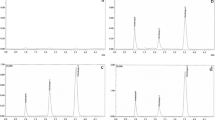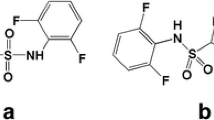Abstract
The residues of flubendiamide from berseem were extracted and cleaned up by the QuEChERS approach and analysed by liquid chromatography/mass spectrometry (LC-MS/MS). The dissipation studies on berseem were carried out by application of flubendiamide at five different dosages i.e. 24, 36, 48, 72 and 96 g a.i. ha−1. The residues reached below determination limit (BDL) of 0.01 mg kg−1 in 7, 10, 10, 15 and 15 days for 24, 36, 48, 72 and 96 g.a.i. ha−1dosages, respectively. Half-life (t1/2) of flubendiamide on berseem was observed to be 1.08, 1.88, 1.94, 2.26 and 2.27 days, respectively, at 24, 36, 48, 72 and 96 g a.i. ha−1. Theoretical maximum residue contributions (TMRC) values reached below the maximum permissible limit (MPI) for 3, 5 and 7 days in treatments at 24, 36 and 48 g.a.i. ha−1, respectively, whereas in case of higher dose treatments i.e. 72 and 96 g a.i. ha−1, the residues of flubendiamide reached below MPI after 10 days of treatment. These data could provide guidance for the proper and safe use of this pesticide on berseem in India.



Similar content being viewed by others
References
Anastassiades M, Lehotay SJ, Stajnbaher D, Schenck FJ (2003) Fast and easy multiresidue method employing acetonitrile extraction/partitioning and “dispersive solid-phase extraction” for the determination of pesticide residues in produce. J AOAC Int 86:412–431
Anastassiades M, Tasdelen B, Scherbaum E, Stajnbaher D (2007) Recent developments in QuEChERS methodology for pesticide multiresidue analysis. In: Ohkawa H, Miyagawa H, Lee PW (eds) Pesticide chemistry: crop protection, public health, environmental safety. Wiley-VCH Verlag GmbH & Co. KGaA, Weinheim
Anonymous (2011) Dairy cattle. In: Verma HK (ed) Package of practices for veterinary and animal husbandry. Guru Angad Dev Veterinary & Animal Sciences University, Ludhiana, p 25
Anonymous (2012) Fodder. In: Gill MS, Bajwa HS (eds) Package of practices for crops of Punjab Rabi 2012–2013. Punjab Agricultural University, Ludhiana, pp 72–84
Australian Pesticides and Veterinary Medicines Authority (2009) http://aprma.gov/registration/assessment/does/prs_flubendiamide.pdf
Bayer AG (2003) Report MR-202/03, Laboratory Project ID: P601030020, Leverkusen.
Chawla S, Patel AR, Patel HK, Shah PG (2011) Dissipation of flubendiamide in/on brinjal (Solanum melongena) fruits. Environ Monit Assess 183:1–4
Das SK, Mukherjee I, Das SK (2012) Dissipation of flubendiamide in/on okra [Abelmoschus esculenta (L.) Moench] fruits. Bull Environ Contam Toxicol 88:381–384
Diaz de Toranzo EG, Brieux JA (1967) Synthesis of unsymmetric o-phthalic acid diamides. J Med Chem 10:982–983
Diez C, Traag WA, Zommer P, Marinero P, Atienza J (2006) Comparison of an acetonitrile extraction/partitioning and “dispersive solid-phase extraction” method with classical multi-residue methods for the extraction of herbicide residues in barley samples. J Chrom A1131:11–23
Ebbinghaus-Kintscher U, Lummen P, Raming K, Masaki T, Yasokawa N (2007) Flubendiamide, the first insecticide with a novel mode of action on insect ryanodine receptors. Pflanzenschutz-Nachrichten Bayer 60:117–140
Gopal M, Mishra E (2008) Analytical method for estimation of a new insecticide flubendiamide and its safety evaluation for usage in rice crop. Bull Environ Contam Toxicol 81:360–364
Gunther FA, Blinn RC (1955) Analysis of insecticides and acaricides. Interscience Publishers Inc, New York, p 696
Hoskins WM (1961) Mathematical treatment of the rate of loss of pesticide residue. FAO. Plant Prot Bull 9:163–168
Knight WE (1985) Miscellaneous annual clovers. In: Taylor NL (ed) Clover Science and Technology. Pp 547–562. No. 25 in the Series Agronomy. American Society of Agronomy, Inc. Crop Science Society of America, Inc. Soil Science Society of America, Publishers, Madison
Kooner R, Sahoo SK, Singh B, Battu RS (2009) Dissipation kinetics of flubendiamide and thiacloprid on tomato (Lycopersicon esculentum Mill) and soil. Qual Assur Safe Crop Food 2:36–40
Mohapatra S, Ahuja AK, Deepa M, Sharma D, Jagadish GK, Rashmi N (2010) Persistence and dissipation of flubendiamide and des-iodo flubendiamide in cabbage (Brassica oleracea Linne) and soil. Bull Environ Contam Toxicol 85:352–356
Nishimatsu T, Hirooka T, Kodama H, Tohnishi M, Seo A (2005) Flubendiamide—a new insecticide for controlling lepidopterous pests. Pp 57–64. Proc. of the BCPC International Congress, Crop Science & Technology, Glasgow, United Kingdom.
Paramasivam M, Banerjee H (2013) Dissipation of flubendiamide residues in/on cabbage (Brassica oleracea L.). Environ Monit Assess 185:1577–1581
Sahoo SK, Sharma RK, Battu RS, Singh B (2009) Dissipation kinetics of flubendiamide on chili and soil. Bull Environ Contam Toxicol 83:384–387
Shane H (2006) Flubendiamide: the next generation in lepidopteran pest management. Annual Meeting of the Entomological Society of America (ESA). Research Triangle Par, NC
Shrestha A, Hesterman OB, Squire JM, Fisk JW, Sheaffer CC (1996) Annual medics and berseem clover as emergency forage. Agron J 90:197–201
Takkar R, Sahoo SK, Singh G, Battu RS, Singh B (2012) Dissipation pattern of flubendiamide in/on brinjal (Solanum melongena L.). Environ Monit Assess 184:5077–5083
Acknowledgment
The authors are thankful to the Head of the Department of Entomology, Punjab Agricultural University, Ludhiana for providing necessary research facilities to carry out these studies.
Author information
Authors and Affiliations
Corresponding author
Additional information
Responsible editor: Laura McConnell
Rights and permissions
About this article
Cite this article
Kaur, R., Mandal, K., Sahoo, S.K. et al. Estimation and risk assessment of flubendiamide on fodder berseem clover (Trifolium alexandrinum L.) by QuEChERS methodology and LC-MS/MS. Environ Sci Pollut Res 23, 9791–9798 (2016). https://doi.org/10.1007/s11356-016-6109-3
Received:
Accepted:
Published:
Issue Date:
DOI: https://doi.org/10.1007/s11356-016-6109-3




